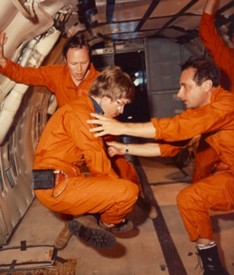
Space adaptation syndrome or space sickness is a kind of motion sickness that can occur when one’s surroundings visually appear to be in motion, but without a corresponding sense of bodily motion. This incongruous condition can occur during space travel when changes in g-forces compromise one’s spatial orientation. According to Science Daily, “Gravity plays a major role in our spatial orientation. Changes in gravitational forces, such as the transition to weightlessness during a space voyage, influence our spatial orientation and require adaptation by many of the physiological processes in which our balance system plays a part. As long as this adaptation is incomplete, this can be coupled to nausea, visual illusions, and disorientation.” Sleep deprivation can also increase susceptibility to space sickness, making symptoms worse and longer-lasting.
According to the sensory conflict hypothesis, space sickness is the opposite of the kinds of motion-related disorientation that occur in the presence of gravity, known as terrestrial motion sickness, such as becoming carsick, seasick, or airsick. In such cases, and in contrast to space sickness, one’s surroundings seem visually immobile (such as inside a car or airplane or a cabin below decks) while one’s body feels itself to be in motion. Contemporary motion sickness medications can counter various forms of motion disorientation including space sickness by temporarily suppressing the vestibular system, but are rarely used for space travel because it is considered better to allow space travelers to adapt naturally over the first one to seven days rather than to suffer the drowsiness and other side effects of medication taken over a longer period. However, transdermal dimenhydrinate anti-nausea patches are typically used whenever space suits are worn because vomiting into a space suit could be fatal by obscuring vision or blocking airflow. Space suits are generally worn during launch and landing by NASA crew members and always for extra-vehicular activities (EVAs). EVAs are consequently not usually scheduled for the first days of a mission to allow the crew to adapt, and transdermal dimenhydrinate patches are typically used as an additional backup measure.
Picture Credit : Google




